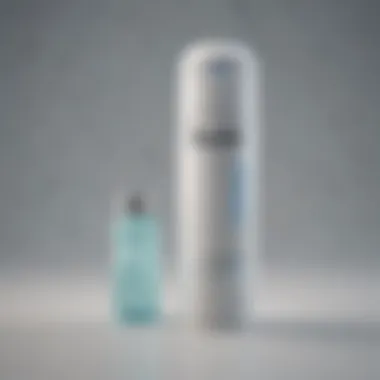Understanding Deodorants vs Antiperspirants: Key Differences


Intro
Understanding the difference between deodorant and antiperspirant is not just a matter of personal care; it has broader implications for health and well-being. Both products aim to combat body odor and perspiration, but they do so through different mechanisms and ingredients. As many people navigate their choices, discussions on platforms like Reddit reveal user preferences, misconceptions, and experiences that shed light on these common products.
This article aims to delve into the science behind deodorants and antiperspirants, examining their functionalities, ingredients, and effects on the human body. Going beyond surface-level understanding, we will explore how these products fit into current market trends and consumer behavior. The insights that will unfold serve to guide readers—students, researchers, and professionals—in making informed decisions regarding their personal hygiene routines.
Prelude to Body Odor Control
Body odor is a complex topic that intersects with personal comfort, social norms, and health considerations. Understanding the mechanisms of body odor can help individuals take charge of their personal hygiene. When sweat combines with bacteria on the skin, it leads to a breakdown that results in unpleasant odors. This biological process creates a demand for effective solutions to manage and minimize odor.
In this article, we will explore two primary products used for body odor control: deodorants and antiperspirants. Each has distinct roles that are influenced by their ingredients and mechanisms of action. Recognizing the differences between deodorants and antiperspirants is crucial for effective odor management and personal care.
By gaining insights into how these products work and what they contain, readers can make more informed choices regarding their body odor control methods. This knowledge allows individuals to align their personal hygiene practices with their lifestyle needs.
The Significance of Personal Hygiene
Personal hygiene is not only about aesthetic appeal; it is also tied to health and well-being. Maintaining good hygiene practices helps prevent infections and skin diseases. Regular bathing and the use of hygiene products can significantly enhance one’s self-image and confidence.
A well-maintained personal hygiene routine can also affect social interactions. People generally respond positively to pleasant scents, which can improve relationships in personal and professional settings. Furthermore, understanding personal hygiene fosters an awareness of one’s own body and its responses to different environments.
Role of Deodorants and Antiperspirants
Deodorants and antiperspirants both play essential roles in body odor control, but they function differently. Deodorants are designed to mask or neutralize body odor without affecting perspiration. Their primary ingredients focus on combating the bacterial growth that leads to odor. On the other hand, antiperspirants aim to reduce sweating itself, thus limiting the moisture on the skin that bacteria thrive on.
This distinction informs consumers about which product may best suit their needs. Individuals who prefer to minimize sweat may lean towards antiperspirants, whereas those more concerned with odor may opt for deodorants. Through this understanding, consumers can better navigate their choices in the vast market of body odor control products.
Defining Deodorants
Defining deodorants is crucial in understanding personal care products. Deodorants primarily aim to mask or eliminate body odor caused by bacteria. They are formulated to neutralize the smell rather than reduce sweat production. This article explores the functionality, composition, and advantages of deodorants. Knowing how deodorants operate assists individuals in making more informed selections based on their needs.
How Deodorants Work
Deodorants function by changing the pH of the skin or by utilizing antimicrobial substances to reduce or inhibit the growth of odor-causing bacteria. The application of deodorants creates an environment where bacterial activity is lessened, thus minimizing the fermentation of sweat and the resulting odor. It is essential to note that deodorants do not stop sweat; they simply make any perspiration less noticeable.
Common Ingredients in Deodorants
Many deodorants contain a variety of ingredients good for odor control. Common components include:
- Antimicrobial agents: Compounds like triclosan help to kill or inhibit bacteria.
- Fragrance: This helps mask body odor.
- Alcohol: It can provide a cooling effect and works to dry the skin.
- Natural ingredients: Many options now feature coconut oil, shea butter, or essential oils, appealing to consumers seeking more natural solutions.
These ingredients can significantly vary based on the target audience, such as those with sensitive skin or those preferring eco-friendly products.
Types of Deodorants
Roll-ons
Roll-ons are popular due to their ease of application. A key characteristic of roll-ons is their liquid format, which allows for even and controlled application on the skin. They are considered beneficial as they often dry quickly and tend to have longer-lasting effects compared to some other types. One unique feature of roll-ons is their capacity to contain alcohol, which can provide a cooling sensation on the skin. However, some users may find that the alcohol content can cause irritation, especially after shaving.
Sprays
Sprays are another common type of deodorant, favored for their fast drying time and breathable application. One of the critical characteristics of sprays is their aerosol delivery system, which allows for a broad distribution of product. This form offers a light finish, which many consumers appreciate. However, a disadvantage may include the potential for over-application resulting in product wastage.
Sticks
Sticks are a traditional form of deodorant that many individuals rely on. They are characterized by their solid structure, providing a straightforward method for application. Sticks are often favored for their longevity and ability to remain effective throughout the day. A unique feature is their packaging, which is often compact and travel-friendly. Possible downsides may include a residue some users dislike, particularly in warmer climates.
Gels
Gels represent a newer format in the deodorant landscape, appreciated for their clear and aesthetically pleasing finish. Their primary characteristic is the transparent formulation that avoids stain issues on clothing. Users often find gels easy to apply and enjoy the instant dry feeling they provide. A unique feature is that they can be absorbed rapidly, sometimes leading to a sensation of coolness on application. Nevertheless, their efficacy might vary based on the brand and formulation.
Benefits of Using Deodorants
Deodorants provide numerous benefits:


- They help control body odor, contributing to a sense of confidence.
- Many formulas are easily accessible and come in various scents to suit personal preference.
- Deodorants can be cost-effective options for maintaining freshness.
- They often contain moisturizing agents, providing skin benefits.
Ultimately, deodorants are essential for routine hygiene and personal care.
Defining Antiperspirants
Understanding antiperspirants is crucial to grasping the broader topic of body odor control. While many people use these products daily, they often do not know how they function or what ingredients are in them. By defining antiperspirants, we can distinguish them clearly from deodorants, which serve a different purpose. Moreover, recognizing their mechanism of action and active components can reveal their benefits and limitations, helping consumers make informed choices.
Mechanism of Action of Antiperspirants
Antiperspirants work primarily by blocking sweat glands. They contain active ingredients that react with sweat to form a gel-like plug. This process significantlty reduces the amount of sweat that reaches the skin's surface. By preventing moisture, antiperspirants not only keep users dry but also inhibit the bacterial growth that contributes to odor. This dual action makes them effective in managing both perspiration and body odor, especially in hot climates or during physical activity.
Active Ingredients in Antiperspirants
The most common active ingredients found in antiperspirants are aluminum compounds, such as aluminum chloride or aluminum zirconium. These ingredients are responsible for the product's ability to temporarily block the sweat glands. Some antiperspirants also include alcohol and certain astringents, which enhance their effectiveness. It is important to note that while aluminum compounds are recognized for their efficacy, there are ongoing debates about their safety, leading some consumers to seek alternative options.
Forms of Antiperspirants
Antiperspirants come in various forms, each with unique characteristics that cater to different consumer preferences.
Solid
Solid antiperspirants are popular due to their convenience and ease of use. They typically come in a stick format that glides smoothly over the skin. Their formulation allows for a thicker application, providing a long-lasting effect. Users appreciate solid antiperspirants because they can last throughout the day, making them effective for people with busy lifestyles. However, some may find that solid formulas can leave residue on clothing.
Liquid
Liquid antiperspirants usually come in spray or roll-on formats. They are known for drying quickly, which appeals to those who prefer a lighter feel after application. The liquid form allows for even distribution, making it easy to apply precisely where desired. However, some users may prefer to avoid liquid products as they might require additional drying time before dressing, affecting overall convenience.
Crystal
Crystal antiperspirants are gaining popularity among consumers seeking more natural options. Made from natural mineral salts, they work by creating a thin layer on the skin that inhibits bacterial growth. Users often choose crystal antiperspirants for their perceived safety and gentle formulation. However, they may not be as effective for individuals who sweat heavily.
Advantages of Using Antiperspirants
The use of antiperspirants presents several advantages:
- Odor Control: By blocking sweat production, antiperspirants significantly reduce body odor.
- Added Confidence: Many users report feeling more self-assured when using effective antiperspirants, particularly in social or professional situations.
- Convenient Usage: Different forms of antiperspirants cater to various lifestyles, ensuring that consumers have practical options to choose from.
By understanding these elements, consumers can better navigate their choices between deodorants and antiperspirants, making decisions that align with their personal needs and preferences.
Comparative Analysis: Deodorants vs. Antiperspirants
Understanding the comparative analysis between deodorants and antiperspirants is crucial for consumers looking to manage body odor and sweat effectively. Both products serve different functions and employ various mechanisms to address issues related to personal hygiene. The distinction between them is not simply a matter of choice but involves an understanding of their efficacy, duration, and user preferences. This section will dissect these elements, providing insight into how each product fits into everyday personal care routines.
Efficacy in Odor Control
Deodorants primarily focus on neutralizing odor. They work by combating the bacteria that contribute to body odor, using ingredients that can mask or eliminate unpleasant smells. Some popular forms of deodorants utilize baking soda and fragrances to achieve this effect.
In contrast, antiperspirants aim to reduce perspiration itself. They contain active ingredients like aluminum compounds, which temporarily block sweat glands, thus limiting moisture release from the body. This dual action of deodorants and antiperspirants highlights a key differentiation; while both combat odor, antiperspirants additionally address sweat, making them potentially more effective in specific situations where sweat is a concern.
Comparative Duration of Effectiveness
When it comes to longevity, the effectiveness of deodorants and antiperspirants can vary greatly. Generally, antiperspirants are designed to provide a longer-lasting effect, often up to 48 hours. This extended duration is often sought after for its practical benefits during active days or in demanding environments.
Deodorants, on the other hand, may need to be reapplied throughout the day to maintain efficacy. Their effectiveness can wane as sweat increases, while their odor-masking ingredients may not hold up under high-pressure scenarios. Users may find themselves needing to rely on frequent applications of deodorants to cover odor, making this aspect a vital consideration when choosing between products.
User Preferences and Sensitivities
Individual preferences are shaped by personal experiences and sensitivities. Some users may prefer the feel of antiperspirants, valuing their moisture control, while others may have sensitivities to the ingredients, particularly aluminum compounds found in many antiperspirants. These sensitivities can lead to skin irritations or allergic reactions, making it essential for consumers to carefully evaluate their skin type and product formulations.
Conversely, those who prioritize natural ingredients might opt for deodorants free from synthetic compounds, despite needing to apply them more often. User reviews on platforms like Reddit reveal a spectrum of opinions, where many express strong preferences or aversions based on their personal experiences with effectiveness and skin reactions.
In summary, the comparative analysis between deodorants and antiperspirants reveals significant differences in their functions, effectiveness, and the reasons users prefer one over the other. Understanding these factors is essential for anyone seeking to make informed choices about personal hygiene.
Health Considerations


Understanding health considerations is critical when selecting between deodorants and antiperspirants. Both types of products serve distinct functions, but they can also carry potential health implications. Knowledge of skin reactions, allergies, and the ingredients used in these products helps consumers make informed decisions.
Health considerations involve evaluating how these products interact with skin, their chemical components, and individual sensitivities. People often experience reactions or develop allergies to certain substances, which can lead to discomfort or irritation. Thus, awareness of these aspects is vital for maintaining skin health and overall well-being.
Skin Reactions and Allergies
Skin reactions are a common concern with the use of deodorants and antiperspirants. Users may experience redness, itching, or a burning sensation, often linked to the formulation of these products. Individuals may also develop rashes or hives that signal an allergic reaction.
Certain ingredients, such as fragrances or preservatives, are more likely to trigger such skin issues. Therefore, it is essential to be mindful of one’s skin type and previous reactions when selecting products. For those with sensitive skin, opting for hypoallergenic options can mitigate potential adverse reactions.
Concerns Over Chemical Ingredients
The ingredients within deodorants and antiperspirants often raise questions about safety and potential long-term health effects. Consumers increasingly scrutinize product formulations to identify harmful substances. Here, we analyze some common ingredients of concern.
Baking Soda
Baking soda, known chemically as sodium bicarbonate, is frequently used in deodorants for its odor-neutralizing properties. This ingredient absorbs moisture and can reduce the construction of bacteria that cause odor, making it a popular choice among natural deodorants.
However, some individuals may find baking soda irritating, especially with prolonged use, leading to increased sensitivity or skin reactions. It represents a dual characteristic: beneficial for many, yet potentially problematic for sensitive skin types.
Aluminum Compounds
Aluminum compounds are central to the function of antiperspirants. They work by temporarily blocking sweat glands to reduce perspiration. This makes them effective in preventing wetness and odor. Aluminum is thus a key component for those seeking maximum control over sweating.
Nonetheless, there are ongoing debates regarding the safety of aluminum in personal care products. Some studies have raised concerns about potential links to health issues, including breast cancer and Alzheimer’s disease, although current research presents no definitive conclusion. Therefore, consumers often weigh the effectiveness of aluminum against perceived health risks.
Fragrances
Fragrances enhance the sensory experience of using deodorants and antiperspirants. They are responsible for the pleasant scents that many users enjoy. However, they fall under scrutiny due to their potential allergenic properties.
Synthetic fragrances can contain numerous chemicals, some of which may irritate sensitive skin or trigger allergies. Many consumers are shifting towards fragrance-free or natural alternatives in response to these concerns. Fragrances add appeal but require careful consideration based on individual sensitivities.
Ultimately, consumers must navigate these health considerations to make educated choices about their personal care products. Adjusting knowledge of ingredients and sensitivities allows for better product selection, thus providing a customized approach to personal hygiene.
Consumer Insights from Reddit Discussions
Understanding consumer insights from platforms like Reddit provides valuable context in dissecting the differences between deodorants and antiperspirants. The discussions highlight real-life experiences and collective knowledge, which can be more authentic than academic articles or marketing campaigns. This section offers an essential perspective, focusing on prevalent opinions, misconceptions, and product preference trends that often emerge from user feedback.
Common Misconceptions Debunked
Reddit users frequently share misunderstandings surrounding deodorants and antiperspirants. One common misconception is that all deodorants prevent sweating. In reality, deodorants primarily mask odor and do not inhibit perspiration. This point is crucial for consumers aiming to choose the right product based on their needs.
Another prevalent myth is that antiperspirants are harmful to health. While some users voice concerns over aluminum compounds, scientific studies have largely found them safe for use. Engaging in discussions allows individuals to confront these myths with factual information.
Real-Life Experiences with Products
Real-life experiences shared on Reddit paint a vivid picture of the effectiveness of various brands. Users often detail their preferences based on skin types, climatic conditions, and daily activities. For instance, individuals with sensitive skin may express dissatisfaction with products containing artificial fragrances or certain chemical ingredients. In contrast, some might champion natural brands like Schmidt's or Native for their non-irritating formulations.
By reading these experiences, potential buyers can gauge the efficacy of products in practical scenarios, providing insights that can sometimes be overlooked in commercial advertising.
Trends in Product Preferences
User discussions reveal trends that reflect broader market dynamics in body odor control products. For example, there is a noticeable shift from conventional to natural products, with many users embracing aluminum-free options. Ingredients such as baking soda or arrowroot powder are gaining popularity due to their supposed gentleness on the skin.
Moreover, the format of the product also influences preferences. Many Redditors prefer sprays for quick application, while others favor stick forms for their ease of use. Tracking these trends allows consumers to identify products that align with personal values regarding health and sustainability.
Demonstrating these consumer insights from Reddit not only enriches the discourse surrounding deodorants and antiperspirants but also empowers potential buyers to make informed choices based on shared knowledge and experiences.
Environmental Considerations
Understanding the environmental considerations related to deodorants and antiperspirants is crucial, as it touches on ecological impacts and sustainability practices. The production and disposal of personal care products can contribute significantly to environmental degradation. In this section, we will explore the sustainability in manufacturing and the effects of packaging waste.
Sustainability in Manufacturing


Manufacturing processes for deodorants and antiperspirants vary widely between brands. Some companies prioritize eco-friendly practices. This includes sourcing raw materials responsibly and reducing carbon footprints. The use of natural ingredients has gained popularity. Many consumers now prefer products that are biodegradable or derived from renewable resources.
The choice of ingredients also impacts sustainability. For example, synthetic chemicals can come from fossil fuels. In contrast, natural alternatives, like shea butter or coconut oil, are often more sustainable. Many brands are now shifting to plant-based formulations. They do this to meet consumer demand and adhere to environmental regulations. However, it is essential for consumers to research companies and verify their claims.
Impact of Packaging Waste
Packaging waste is a major concern in the beauty industry, including deodorants and antiperspirants. Traditional packaging, often made of plastic, contributes to a growing landfill problem. In effort to combat this, some brands are adopting recyclable or reusable packaging. However, these practices vary widely. Not all materials marked as recyclable will actually be processed correctly at local facilities.
Moreover, the amount of packaging used can also vary. Some products might offer eco-refills, which reduce overall waste.
"Smart consumers consider both the product and its packaging when making a purchase."
Being aware of packaging can lead to more conscious choices. Brands that emphasize minimalistic or sustainable packaging can offer a better environmental impact.
In summary, environmental considerations involve evaluation of manufacturing practices and packaging waste. Both areas can lead to more informed consumer choices which ultimately influence the market towards more sustainable paths.
Making Informed Choices
Making informed choices about deodorants and antiperspirants is crucial for individuals seeking to manage body odor and perspiration effectively. Each product category serves distinct functions and offers various benefits. Knowledge of these differences aids consumers in selecting the right product that suits their personal needs and aligns with their lifestyle.
Here are some specific elements to consider when making choices about deodorant and antiperspirants:
- Understanding Skin Type: Different skin types may react differently to various ingredients. People with sensitive skin might prefer formulas with fewer irritants.
- Lifestyle Considerations: An active lifestyle may require stronger protection against odor and moisture. In contrast, individuals with less activity might prefer a lighter option.
- Ingredients Awareness: Being aware of the ingredients can guide users away from components that may trigger allergies or other reactions.
These considerations help people make choices that enhance effectiveness while minimizing adverse effects.
Identifying Personal Needs
Identifying personal needs is the first step in choosing between deodorants and antiperspirants. This involves understanding one’s own body chemistry and preferences.
- Assessing Activity Levels: Individuals who exercise frequently may need a stronger antiperspirant. Those who lead a less active lifestyle might choose a basic deodorant for everyday use.
- Determining Sensitivity: Some consumers are sensitive to certain ingredients, particularly fragrances or alcohols. Learning how your skin reacts can help in selecting a suitable product.
- Aesthetic Preferences: The form of the product, whether solid, liquid, gel, or spray, can impact user experience. Identifying personal preferences can ensure satisfaction in daily use.
By analyzing these factors, consumers can narrow down their options effectively.
Testing and Trials
Testing and trials play an essential role in selecting the right product. It is often not enough to rely solely on labels or advertising claims.
- Sampling Different Products: Trying various deodorants and antiperspirants can provide insights into what works best. Many stores offer samples, which is a pragmatic approach for first-time users or those switching products.
- Conducting Patch Tests: Before committing to a new product, performing a patch test can help avoid any potential allergic reactions. Apply a small amount on an inconspicuous area of the skin and wait for reactions.
- Monitoring Performance: Keep track of each product's effectiveness in daily routines. Note how long the product holds up during different activities or weather conditions.
Through methodical testing, individuals can make well-informed decisions based on performance and personal comfort.
The End
The exploration of deodorants and antiperspirants reveals significant insights for consumers. Understanding the differences between these two products is vital for making informed choices. This article emphasizes the importance of knowing how each type functions, their ingredients, and potential health implications. With various options available—such as roll-ons, sprays, and sticks—it is crucial for individuals to assess their personal needs and skin sensitivities.
"Choosing between deodorants and antiperspirants is not just a matter of preference but an informed decision about personal health and lifestyle."
In summary, consumers will benefit from knowledge of efficacy in odor control and duration of effectiveness. It is also vital to consider user preferences disclosed in communities like Reddit. These discussions often shed light on misconceptions and experiences that can alter buying decisions.
Summary of Findings
The findings of this article underscore distinct variances in functionality and ingredients between deodorants and antiperspirants. Deodorants primarily neutralize body odor through fragrance and antimicrobial properties. In contrast, antiperspirants focus on reducing sweat production via aluminum compounds. Additionally, user preferences vary based on personal comfort and skin reactions, influencing their choice of products.
Key points include:
- Deodorants combat odor but do not stop sweat.
- Antiperspirants contain active ingredients to block sweat glands.
- User experiences often define perceptions of effectiveness and safety.
Understanding these aspects helps in navigating the market effectively, ultimately allowing for personalized choices that align with individual lifestyle and health concerns.
Future Research Directions
Future research within the realm of body odor control could focus on several areas. Firstly, more comprehensive studies on long-term skin reactions to various ingredients in both deodorants and antiperspirants would be beneficial. This could help redefine safety standards and reveal better alternatives for sensitive skin.
Moreover, examining the ecological impact of deodorant and antiperspirant products, particularly considering the growing concern for sustainability, can guide manufacturers toward more environmentally friendly practices.
Potential research topics include:
- The impact of aluminum in antiperspirants on health.
- Innovations in natural deodorant formulations.
- Consumer education on ingredient awareness and health implications.
With these topics, researchers can better inform consumers and support the development of effective and safe products. This ongoing discourse ensures that personal hygiene practices can adapt to evolving consumer expectations and environmental considerations.



